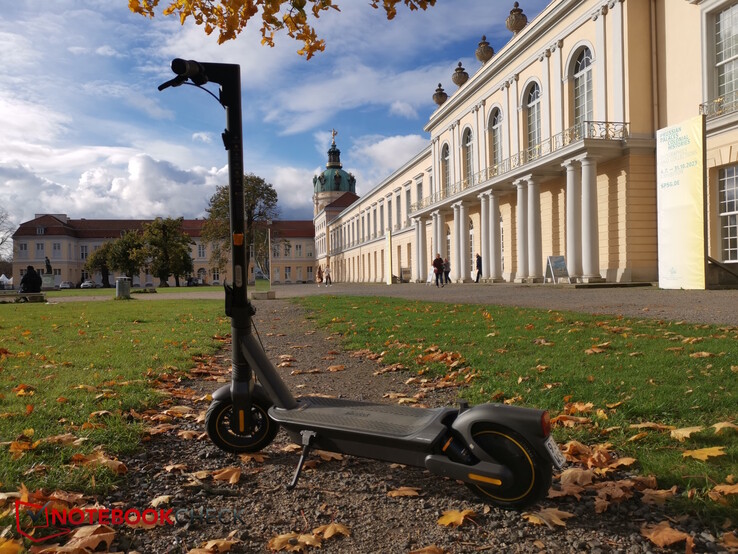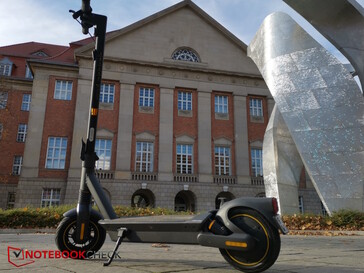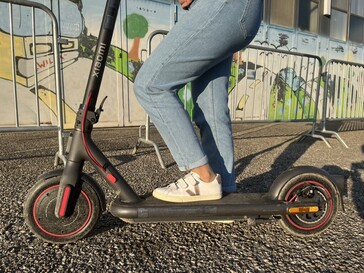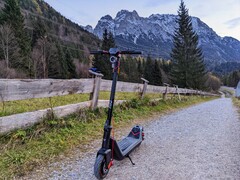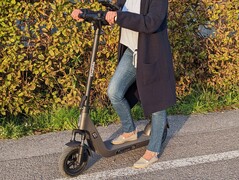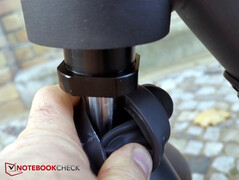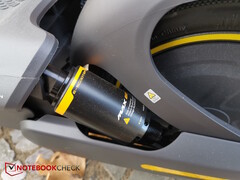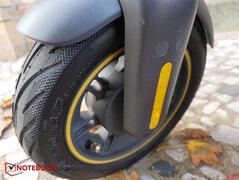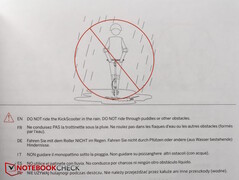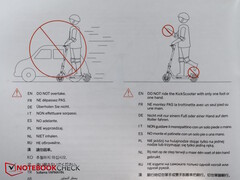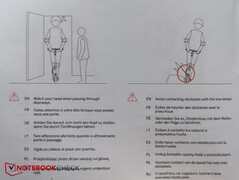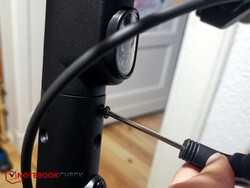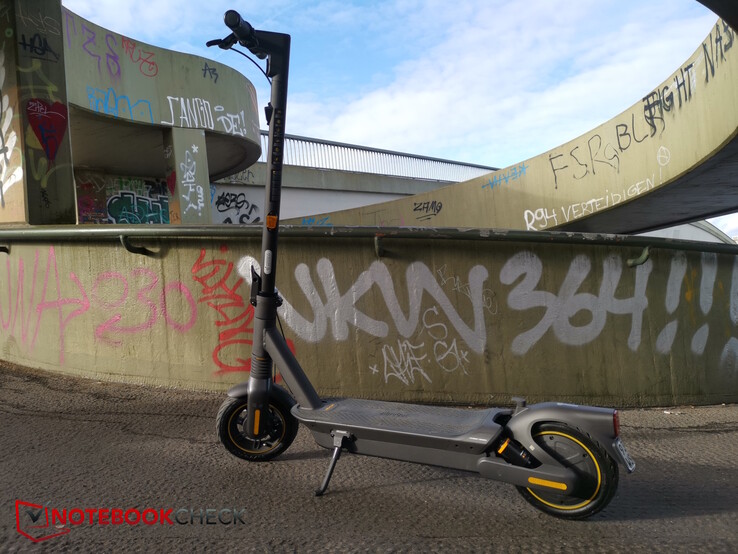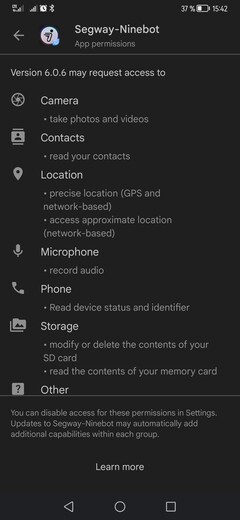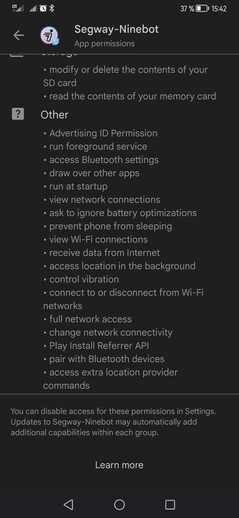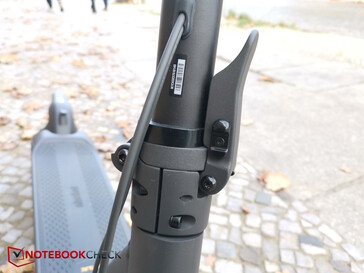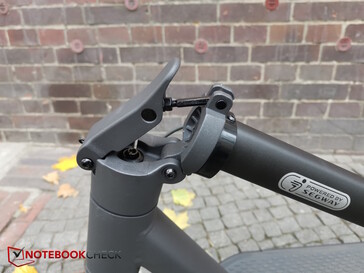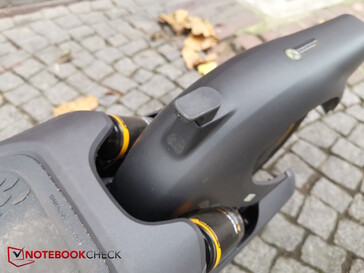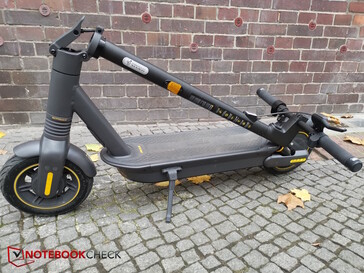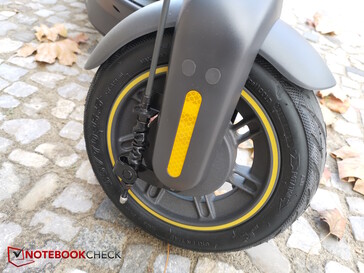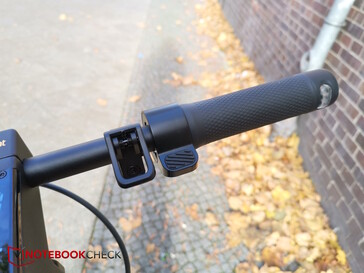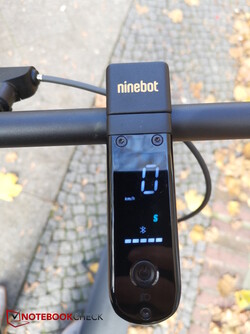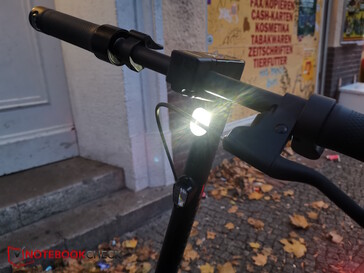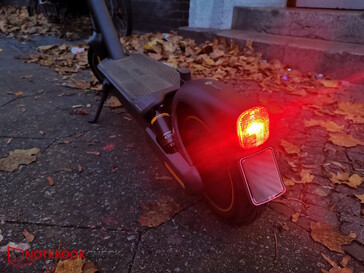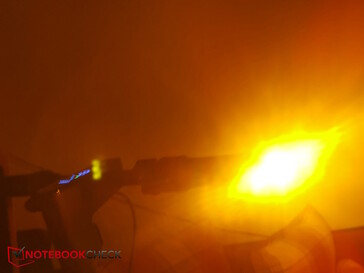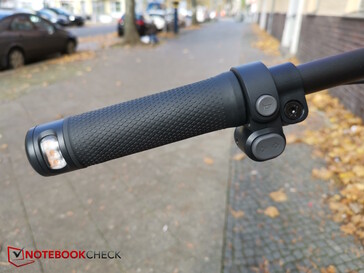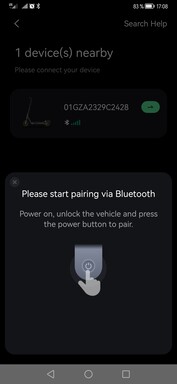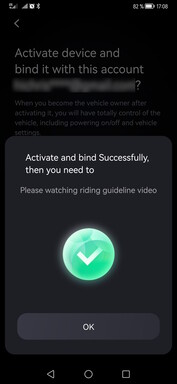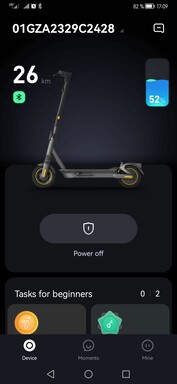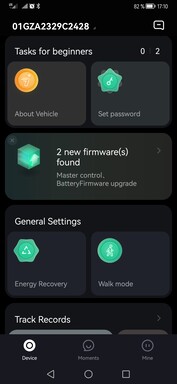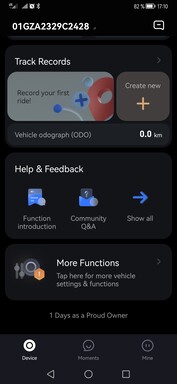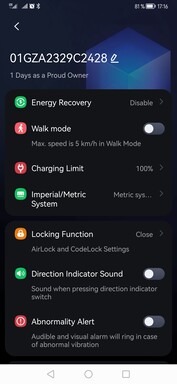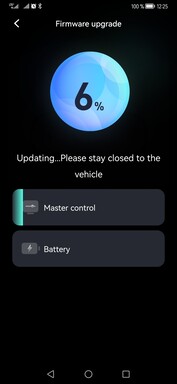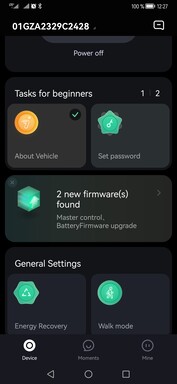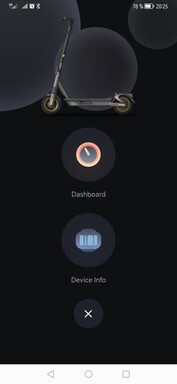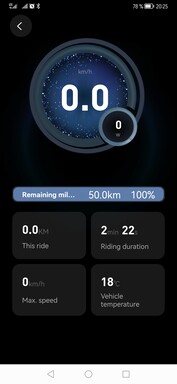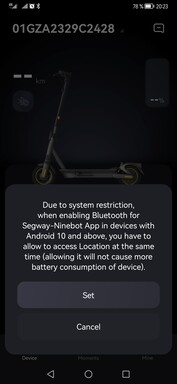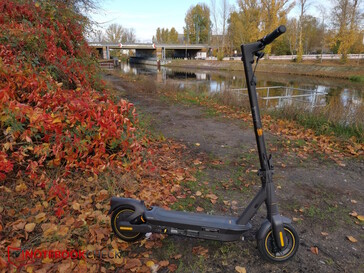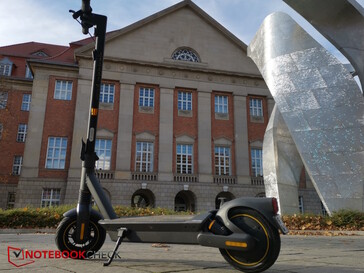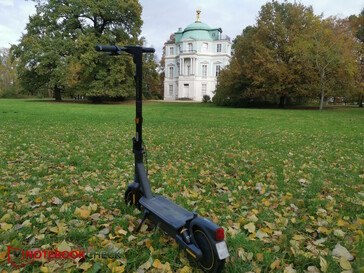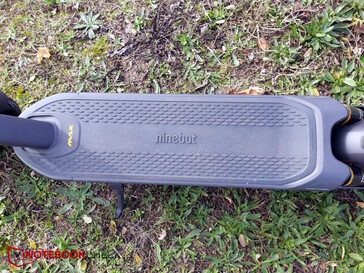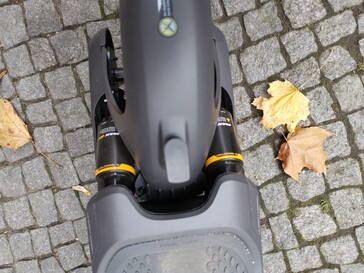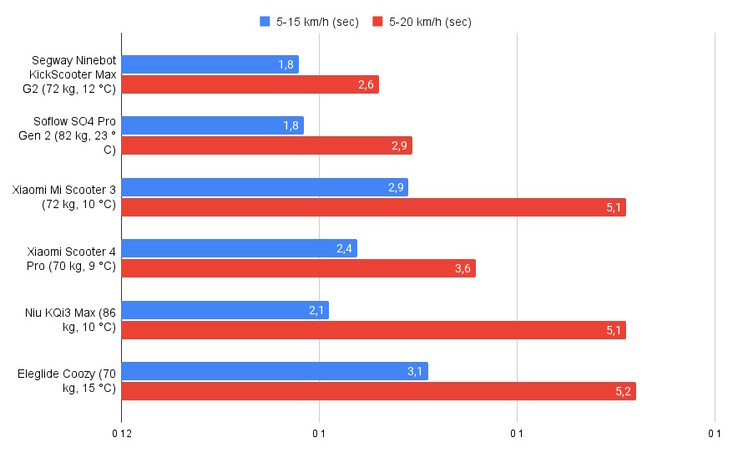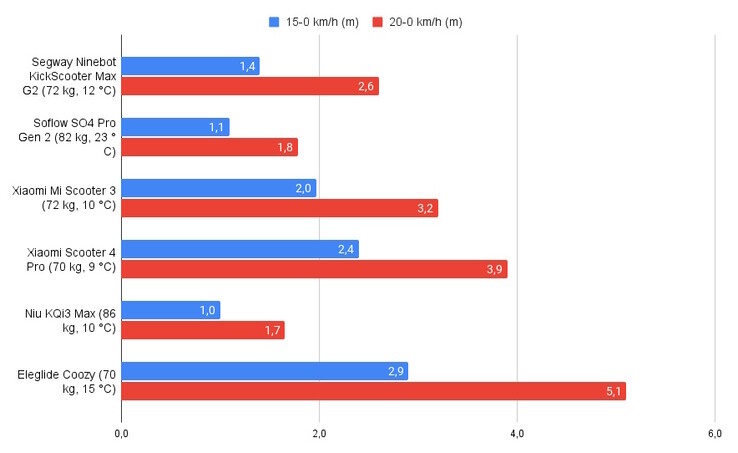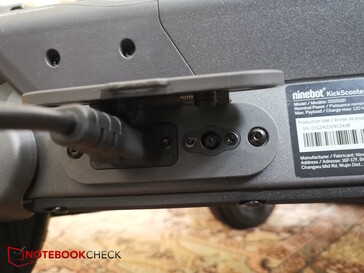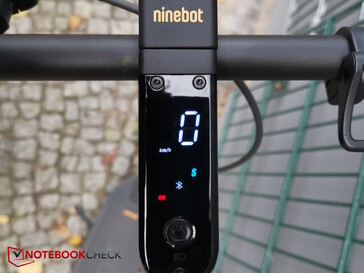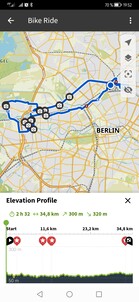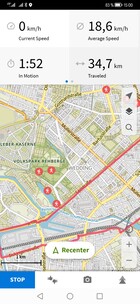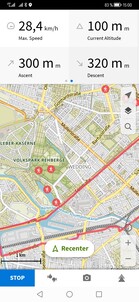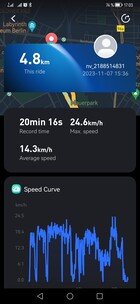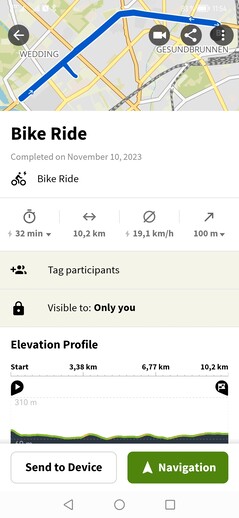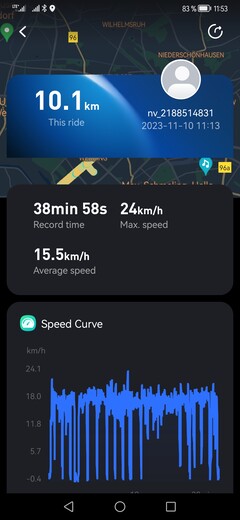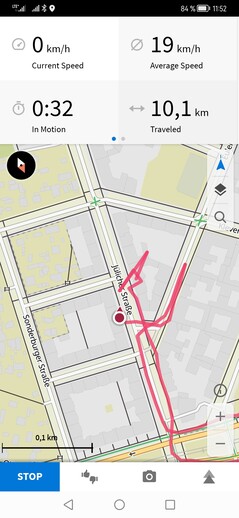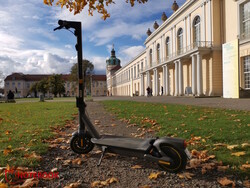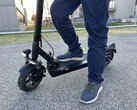Segway Ninebot KickScooter Max G2 E-Scooter review: Great handling thanks to full hydraulic suspension
By now, Segway is known as a sub-brand of the Chinese company Ninebot, which acquired the American manufacturer a few years back. Alongside the F2 D and F2 Plus D, the Max G2 is one of the new models released by the company in 2023. Weighing more than 24 kg (53 lb), the Max G2 takes quite a bit of muscle power to haul onto trains and is one of the heaviest e-scooters in its class. On the other hand, it boasts a large motor, great range and a full suspension that provides a significantly more comfortable riding experience than lighter entry-level models, such as the Xiaomi Mi Electric Scooter 3, which we have likewise reviewed.
This means the Max G2 is mainly up against similarly spec'd e-scooters, like the SoFlow So4 Pro Gen 2 and Niu KQi3 Max, and possibly the €50 cheaper Xiaomi Electric Scooter 4 Pro.
Comparison with possible competitors
| Ninebot KickScooter Max G2 | SoFlow So4 Pro Gen 2 | Niu KQi3 Max | Xiaomi Electric Scooter 4 Pro | Eleglide Coozy | |
|---|---|---|---|---|---|
| Battery capacity | 551 Wh | 504 Wh | 608 Wh | 446 Wh | 450 Wh |
| Rated power / Max power | 450 / 900 Watt | 500 / 1000 Watt | 450 / 900 Watt | 350 / 700 Watt | 350 / 700 Watt |
| Max climb grade | 22 % | 27-33 % | 25 % | 20 % | 15 % |
| Weight | 24.25 kg | 18.73 kg | 21.1 kg | 17.4 kg | 18.7 kg |
| Wheel size | 10" | 10" | 9.5" | 10" | 10" |
| Max load | 120 kg | 150 kg | 120 kg | 120 kg | 120 kg |
| Price | €800 | €800 | €900 | €750 | €600 |
Technical specs - Full hydraulic suspension and integrated charger
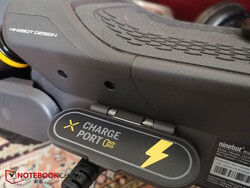
The charger is already built into the Max G2. Even though this makes the e-scooter heavier, it ensures that you only need a power cable to recharge the vehicle. According to the included pamphlet, however, you will need to order the cable directly from the manufacturer if it becomes damaged. The 551 Wh battery should typically have enough juice to last 50 km (31 mi). In extreme cases, it is possible to reach up to 70 km (44 mi) if you ride efficiently and enable Eco mode.
One highlight of the product is definitely its suspension: the handlebar is fitted with a damper at the front, and two shock absorbers at the back ensure a comfortable ride. Both suspension mechanisms are hydraulic. The two tyres are pneumatic but tubeless, and are also self-healing when damaged.
Though the e-scooter has an IPX5 rating, the instruction manual says you shouldn’t ride it in the rain or wet conditions.
| Technical specs | Ninebot KickScooter Max G2 |
|---|---|
| Model | 051501D / 051501E (Germany / Europe) |
| Battery | 551 Wh |
| Charge time | 6 h |
| Drive system | Rear wheel drive with brushless 450-watt motor |
| Top speed | 20 km/h (G2 D) /25 km/h (G2 E) |
| Range according to manufacturer | max. 70 km; typically 50 km |
| Charger | 121.8 watt |
| Max load | 120 kg |
| Tyres | 10 inch, pneumatic, tubeless |
| Brake system | Electronic brake (rear), drum brake (front) |
| Gewicht | 24.25 kg |
| Dimensions | 1210 x 570 x 1264 / 605 mm (unfolded / folded) |
| Lighting | front and back LED lights, LED indicators on bar ends |
| Other features | App connectivity; electric lock on drive unit |
Unboxing & assembly - six screws and ready to go
The scooter is shipped in a large printed cardboard box. And its components are secured using plastic.
The e-scooter is quick to set up because most of the parts are already pre-installed right out of the box. All you have to do is to tighten a total of six screws on the handlebars; the required tool is included. In the box, you’ll also find a valve extender that makes inflating the tyres more convenient, a charging cable as well as an instruction manual and various other documentation.
The photos don’t really do justice to the size of scooter. Even though it may look like any other e-scooters, the Max G2 is larger in real life. The new scooter has an even longer handlebar pole than its predecessor, meaning that tall riders no longer have to bend down as much as on the previous model or the Xiaomi Mi Electric Scooter 3 (height of handlebar pole: 126 vs. 114 cm, or 50 vs. 45 in).
The Max G2 likewise has a considerably higher (20 vs. 15 cm, or 7.9 vs. 5.9 in) and wider (18 vs. 14.5 cm, or 7.1 vs. 5.7 in) footboard than the Mi Scooter 3, thus allowing you to ride in a fairly high position. This is also noticeable when kick-starting the Max G2, as it requires a little more effort to push off than lower e-scooters.
The battery needs to be activated before the scooter is switched on for the first time. All you have to do is plug the scooter into mains power for three seconds, and the scooter will turn on after that. Even if the battery is pre-charged, you won’t be able to start using the Max G2 right away because it will keep on beeping and asking to be connected to the app first. Otherwise the product will limit its max speed to 15 km/h (9.3 mph) and continue with the annoying beeping. The aforementioned Xiaomi Mi Electric Scooter 3 also has a similar app requirement.
So then you are forced to download the Segway-Ninebot app and pair the vehicle with a smartphone. But you can’t do this without granting location permission. The safety tutorial is also unskippable. Once the pairing process is complete, the scooter is activated and can be used without the app.
Let’s get the downside out of the way first: the Max G2 is heavy, very heavy. You'll need the strength of both arms to carry it around; a person can probably only hold it for a few seconds in one hand. This is especially because the scooter’s centre of gravity is uncomfortably far towards the rear when it’s being carried. The Max G2 thus doesn’t lend itself very well to being carried up and down several flights of stairs regularly and should be taken on trains only if it is absolutely necessary.
As expected, the handlebar pole can be folded down. There is a safety mechanism that needs to be pushed up before you can release the locking lever for the pole. The lever itself stays very firmly in place and takes a significant amount of force to pull away from the pole. Afterwards, the pole can be folded down and secured to the rigid rear fender using a hook on the handlebars. Unlike on the Xiaomi, the hook doesn’t double as a bell since the Max G2 is fitted with a loud electronic horn.
Features and operation - Standard display and three riding modes
Speed is regulated using a thumb throttle on the right, and braking is done using a lever on the left. In addition, three riding modes are available in the settings (Eco, Standard, Sport). The German version has a speed limit of 15 km/h (9.3 mph) in Eco mode and 20 km/h (12.4 mph) with slightly reduced acceleration in Standard mode. It can reach speeds of 22 km/h (13.7 mph) in Sport mode. Outside Germany, the Max G2’s top speed is capped at 25 km/h (15.5 mph), and you can even go as high as 35.4 km/h (22 mph) in the US.
The built-in display is as usual located in the centre of the handlebar pole and measures roughly 4.2 x 2.4 cm (1.7 x 0.9 in). It looks almost just like the one on the Xiaomi and shows the most essential information. For example, the battery percentage is shown when charging. During a ride, the speed, riding mode, lighting status, battery level and Bluetooth status are provided. We miss having a mileometer on the scooter, particularly during a ride; this information is only available in the app. Considering every ancient bike computer is capable of indicating the trip and/or overall distance, we wish manufacturers would provide more data on their displays.
Lighting setup - Indicator and horn on the Max G2
The lighting setup is excellent. The Max G2 is equipped with not only a bright front light and a rear light that has grown in size, but also turn indicators on the left and right side. These indicators are located at the very ends of the grips and direct light both forwards and backwards. The display tells the rider whether the blinkers and the lights are activated.
But because the front light is placed quite high up, one of the cables leading to the handlebars is always slightly in its way. The brake cable hangs just in front of the headlight and interferes with the beam.
The electronic horn is very loud and may even be audible to motorists. The lights and horn are control with the left thumb.
App and smart features - Complicated and sluggish
As previously mentioned, it is necessary to connect the scooter to the app once in the beginning, or else it will cap its top speed at 15 km/h (9.3 mph) and beep incessantly. In theory, you can use the device without the app afterwards.
However, the app provides you with useful settings and additional information. This is especially crucial considering that the scooter’s on-board display only shows very rudimentary info.
The numerous extra options include the level of energy recovery through regenerative braking (three settings: Strong, Weak, Off), a walk mode, the battery’s charging behaviour, a code lock and an anti-theft feature that makes the scooter start flashing its lights and beeping loudly when it detects abnormal vibrations.
There are also some less common settings, such as traction control (currently still in beta phase). The e-scooter is also compatible with Apple Find My, which helps you find the device more easily in case you lose it.
Though feature-rich, the app is very unintuitive, complicated and incredibly slow and definitely needs to be optimised.
First off, it is unclear where certain things are located in the app. The actual options are found in “More Functions” at the very bottom of the home screen. At the same time, you can click on the image of the scooter at the top to access a new (intermediate) not-very-useful screen that lets you get to either a dashboard with ride information (speed data, trip distance, etc.) or device information with another click. At this point, you are already in the third sub-level of the app – which makes relatively little sense.
To top it all off, a blank screen with a loading circle seems to appear for a few seconds after every single click, even though all you're doing is accessing a simple sub-menu. It remains a mystery what takes this app so long to load.
Overall, the app is not very easy to navigate, needlessly complicated and annoyingly slow at that. It would benefit from having a menu with no more than two levels and a well-structured home screen that lets you access all options. We find it strange that the app still suffers from such growing pains despite having certainly been around for a long time.
Handling and comfort - Fantastic and very high up
Our test route stretches from the northwestern part of Berlin, staying along the ring of Gesundbrunnen to Charlottenburg Palace, through the Palace Gardens (non-asphalt paved roads) and a little bit farther. We then took the same route back and subsequently rode on a gloriously smooth asphalt bike path right next to an autobahn and through Seestraße. During the ride, we encountered a few minor climbs across bridges, a spiral ramp leading up a bridge (see photo below) and a steep climb in the Palace Gardens.
The powerful 450-watt motor propels the e-scooter forward with great force during acceleration. You can notice a clear difference here when comparing it with the 300-watt offered by the Xiaomi Mi Electric Scooter 3. If the indicator is to be trusted, the scooter can travel consistently at a top speed of 22 km/h (13.7 mph) rather than 20 km/h (12.4 mph). This, together with the fast acceleration, gives riders the feeling that they can go slightly faster than on the abovementioned Xiaomi scooter. We didn’t notice any appreciable delay between pushing on the throttle and the scooter responding. In this regard, the Max G2 also feels nice and snappy. With energy recovery disabled, the scooter is able to continue free-rolling for a long time, meaning the motor has rather low resistance. Depending on the environment, motor noise can range from hardly noticeable to completely inaudible (e.g. on the road).
On the other hand, the brakes have relatively soft tuning, and this applies to the brake lever as well. Consequently, you need to pull the lever almost all the way to the grip in order to brake hard. But at least you are not in danger of flying over the handlebars if you ever slam on the brakes with less care.
The footboard is pleasantly wide and long and provides a comfy place to stand on. The Max G2 is very comfortable to ride not least because of its size, weight and suspension, which does an excellent job in our opinion. We caught ourselves instinctively tensing our body in anticipation of bumps ahead (something we learnt from our experience riding scooters without suspension), only then to marvel at how gently the Max G2 glided over them. The rear shock absorbers only produce a slight rattling noise when dealing with larger potholes. We even rode the scooter over rough cobblestone paths (not a problem on flat roads). Of course, this wasn’t a pleasant experience, but it is amazing how much vibrations the scooter itself can absorb in such an extreme scenario. What’s more, you can even adjust the stiffness of the rear suspension slightly to suit your needs by turning the shock absorbers from “Soft” to “Hard” or vice versa.
Unfortunately, the “Cruise Control” feature isn’t available in strait-laced Germany, meaning you have to keep the throttle pressed with your thumb even when riding on long stretches of straight and even road.
Acceleration and braking
Acceleration is genuinely superb in Sport mode and roughly as good as on the SoFlow So4 Pro Gen 2 (which boasts a 500-watt motor), with rider weight taken into account. The Max G2 may even be slightly ahead in this department.
Many scooters with disc brakes can decelerate with considerably more immediacy and power than the Max G2, which has a front drum brake as well as an electronic rear brake. You don’t need to be as cautious when braking on the Max G2, but this also increases the stopping distance by a smidge.
Battery and charging - Built-in charger
The battery has a capacity of 551 Wh and can be charged via two different ports. Ninebot has included a 230V cable with which the scooter can charge at up to 2A. The second port is designed for use with a 42V round plug and can handle up to 5A.
The charger is conveniently integrated into the Max G2, meaning you only need an appropriate cable to recharge the battery rather than a bulky power adapter. But as mentioned earlier, this makes the scooter heavier. A good compromise solution between weight and convenience would have been a removable battery, like the one in the So4 Pro Gen 2. The battery in the Ninebot is sadly non-removable.
Ideally, you should recharge the battery the night before a ride because the process takes around six hours. When the scooter is charging, the display will light up and show the current battery percentage. The battery level bars will flash from one to five to indicate the charging progress. The rear light will also illuminate, which seems like unnecessary extra power usage. When the battery is full, the built-in charger and display will simply switch off to prevent overcharging.
Range
Ninebot claims the e-scooter has a max range of 70 km (43.5 mi) and can typically cover around 50 km (31.1 mi). We took the Max G2 on our very varied test ride through Berlin (see above: smooth flat asphalt, park trails and a few climbs onto bridges). The rider weighed around 72 kg (158.7 lb), and outside temperature was around 12°C (53.6°F).
In Sport mode (max speed of 22 km/h in Germany, or 13.7 mph), the e-scooter lasted 41 km (25.5 mi) and was really close to being fully drained. The average speed was 18.6 km/h (11.6 mph) according to Komoot. The Ninebot app, however, indicated an average speed of 14.3 km/h (9.1 mph). The brief stops were probably taken into account in this estimate, as otherwise both apps reported very similar data.
Our second test route was “only” 10 km long (6.2 mi), but Standard mode was used this time round. The scooter accelerates noticeably slower in this mode. This trip involved riding 5 km (3.1 mi) on the bike path along the straight Seestraße and then back in the opposite direction. Apart from the times we stopped at traffic lights, we rode the Max G2 at full throttle. Consequently, our average speed was 19.1 km/h (11.9 mph) according to Komoot, whilst the Ninebot app only indicated 15.5 km/h (9.6 mph). The difference is likely due to stop times at traffic lights (Komoot’s Time in Motion vs. Ninebot app’s Record Time).
After the 10 km ride, the battery level dropped from 100% to 87%. We then fully recharged the battery using 103.7 Wh of power. This is equivalent to roughly 10.4 Wh used per kilometre. The estimate suggests the Max G2 can theoretically cover 53 km (32.9 mi) on a single charge, which is close to the typical range claimed by the manufacturer.
The Max G2 is perhaps only able to reach 70 km (43.5 mi) in Eco mode and under ideal conditions (straight path, smooth asphalt, high energy recovery). You can thus expect to get a range of about 40 km (24.9 mi) in Sport mode and roughly 10 km (6.2 mi) more in Standard mode.
The scooter can keep up its performance for a long time thanks to its large battery. And although the performance does decline at low battery levels, you may wonder when this actually sets in and how much performance is actually lost. This is because this decrease is very subtle and seemingly ramps up so slowly and gradually that you would hardly be able to tell. The Max G2 will only drastically reduce its performance and seldom reach 20 km/h (12.4 mph) when the last of the five battery bars start glowing red. But even then, there is still enough juice left for another few kilometres (approx. 2-4 km).
Pros
Cons
Verdict - Great handling, if only it weren't so heavy
The Segway Ninebot KickScooter Max G2 offers one of the best – if not the very best – handling amongst e-scooters under €1,000 (US$1,072). The front and rear hydraulic suspension is not just a marketing ploy but rather a real asset to the product. It allows the scooter to roll smoothly over most bumps on the road. The high handlebars and large footboard let users assume a comfortable position when riding the scooter.
That said, due to how heavy it is, the Max G2 isn’t going to be for absolutely everyone interested in buying an e-scooter. People who have a long commute to work and are only looking for an e-scooter to cover the last few kilometres or to replace a bus ride from the train station to their workplace, are going to quickly find dragging the scooter around a chore. This similarly applies to those who live on high floors. The scooter’s weight is both a curse and a blessing: it ensures that the vehicle is smooth and comfortable to ride, but carrying the Max G2 around is something you won't really want to do. The scooter is also huge and bulky and may not fit inside smaller car boots.
In addition, Ninebot really needs to rework or optimise their app. The constant load screens and obtuse menus are less than optimal.
The Segway Ninebot KickScooter Max G2 offers one of the best handling amongst e-scooters under €1,000 (US$1,072). However, you should ideally not have to carry it often, as it is too heavy.
Those who want a smaller, more portable e-scooter to bring on trains should instead take a look at more lightweight options from Xiaomi and the like. But if you aren’t fazed by the Max G2’s weight, we can recommend it without reservation.
Price and availability
Transparency
The selection of devices to be reviewed is made by our editorial team. The test sample was provided to the author as a loan by the manufacturer or retailer for the purpose of this review. The lender had no influence on this review, nor did the manufacturer receive a copy of this review before publication. There was no obligation to publish this review. As an independent media company, Notebookcheck is not subjected to the authority of manufacturers, retailers or publishers.
This is how Notebookcheck is testing
Every year, Notebookcheck independently reviews hundreds of laptops and smartphones using standardized procedures to ensure that all results are comparable. We have continuously developed our test methods for around 20 years and set industry standards in the process. In our test labs, high-quality measuring equipment is utilized by experienced technicians and editors. These tests involve a multi-stage validation process. Our complex rating system is based on hundreds of well-founded measurements and benchmarks, which maintains objectivity. Further information on our test methods can be found here.


